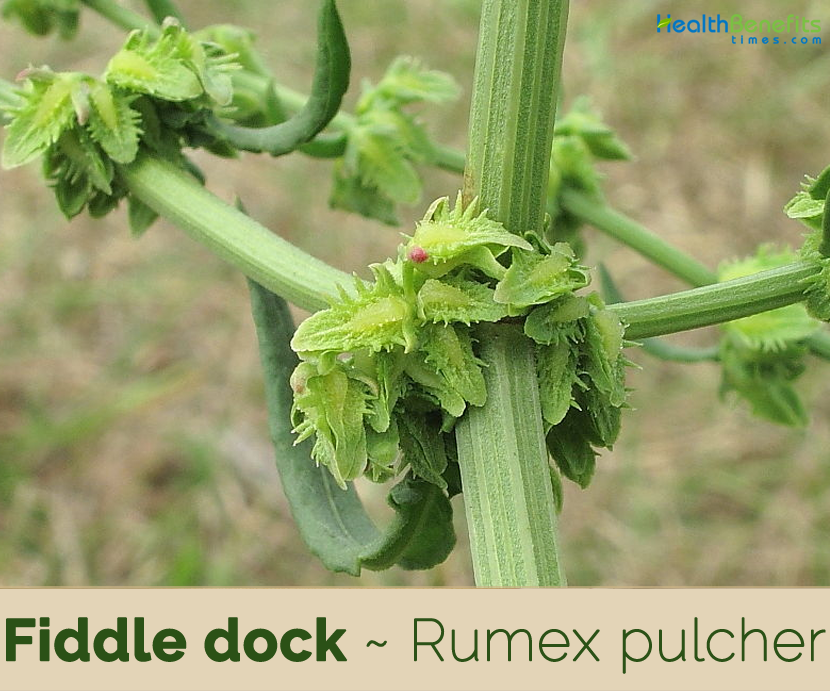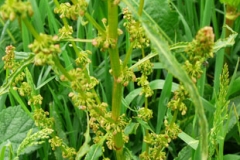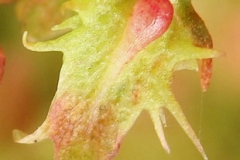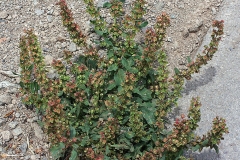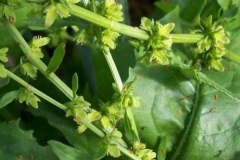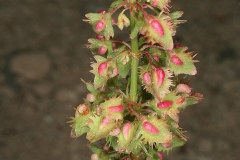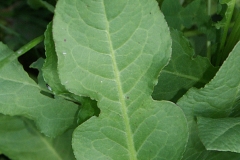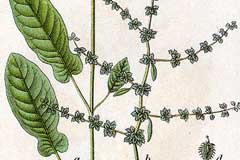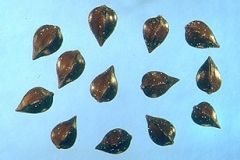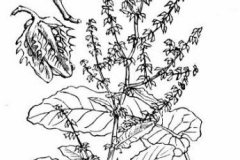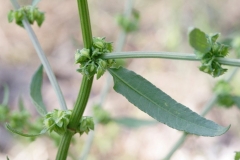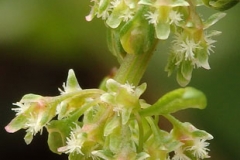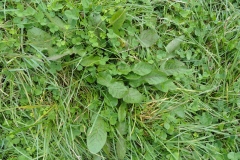Fiddle dock gets its name from having leaves shaped like a fiddle (or violin). It is a common dock species found throughout New Zealand. It is probably not quite as common as broad-leaved dock within pastures. However, because it tends to be a bit smaller than many of the other dock species, it is better able to tolerate regular mowing and so is typically the main dock species found in turf. Under regular mowing, it grows very flat to the ground and has smaller leaves than in a pasture or waste area situation. Within turf, it never really gets an opportunity to set seed as the seed-head gets removed by the mower before it has developed very far (unless of course the turf is seldom mowed). Fiddle dock is a perennial weed with a tap-root, and grows as a rosette with its leaves radiating out from a central growing point located at ground-level.
Plant Description
Fiddle dock is a biennial or short-lived, much-branched perennial herb that grows about 1 m tall. The plant is found growing in pastures, waterways, wasteland, roadsides, railway yards, other habitats near settlements, roadsides, coastal pastures, commons and churchyards. The plant prefers shallow, winter water logged, duplex and sandy soils. The plant has multiple taproots like small dark brown carrots up to 200 mm long and 20 mm wide. Short, thick underground stem or crown is on top of the taproots. Stem is erect, pithy or hollow, fluted, stiff, slender, 200-1000 mm tall and hairless. It is branched from the base and much branched along their length. Branches are usually at right angles to the stem and almost horizontal.
Leaves
Leaves are ovate-oblong, 3-16 cm long, fleshy, papillate or hairy on the veins below, slightly cordate at the base. Lower leaves are pandurate and upper leaves are lanceolate. Margin is finely scalloped. The top of the plant may bend, especially as the fruit develops.
Flower & Fruit
The inflorescence is made up of many branches, each an interrupted series of clusters of flowers with up to 20 in each cluster, each flower hanging from a pedicel. The flower has usually six tepals, the inner three of which are edged with teeth and have tubercles at their centers. Flowering normally takes place from September to December in WA and October to December in SA. Fertile flower are followed by trigonous brown nut, covered by thick valves, reticulate and toothed, with up to 9 teeth almost spiny. Seeds are triangular pyramid nut, glossy, pale to dark brown, 1.5-4 mm long x 1 mm wide, widest below the middle.
History
Some species of this genus (with the name of lapathum and other related ones), were described by Dioscorides and Pliny the Elder (first century AD), pointing out their medicinal properties and their use as a vegetable medicine. Some of these attributed properties are very similar to those registered in modern ethno-botanical works. The consumption like spinach of this wild vegetable in central Spain, especially in times of scarcity, is mentioned, together with other species, by Cienfuegos.
- Although this plant has been mainly used as a wild green, it has other minor uses in medicine and ethno-veterinary.
- Leaves, both eaten as a vegetable or in infusion, and also the flowers and fruits, have been traditionally considered as digestive, anti-diarrheic, and anti-catarrhal in several Spanish regions.
- As registered by Blanco, poultices made with the leaves were used against boils and infected grains, along with the leaves of the white henbane.
- In ethno-veterinary it has been employed to treat urogenital myiasis and respiratory affections.
Culinary Uses
- Leaves can be consumed raw or cooked.
- Leaves can be added to salads, they have an acid flavor.
- It is a wild vegetable traditionally consumed in some Mediterranean countries, as recorded in Spain, France, Italy, Croatia, Greece, Turkey, Cyprus and Jordan.
- Its tender basal leaves are collected mainly in springtime, although they can also be gathered during mild winters.
- They are also prepared in wild vegetables mixtures at least in Greece, Italy, and Croatia, such as the Italian pistic (a vegetable dish from the region of Friuli elaborated with a mix of up to 54 wild vegetables), and the Croatian svakober, which translates as “pick all”, where the plants are boiled for 20–30 min, strained and sprinkled with olive oil, and served as a side dish.
- These mixes are occasionally used as stuffing in vegetable pies.
- In Cyprus these pies, which are called pittes, include up to 11 plants that are boiled or fried along with rice or pourgouri (like couscous) and spices.
- This species has been also consumed in omelets, used for preparing a sauce to accompany meat, and more occasionally eaten raw in salads.
Other facts
- Although no specific mention has been made for this species, dark green to brown and dark grey dyes can be obtained from the roots of many species in this genus, they do not need a mordant.
- Its leaves were also used as animal fodder.
- In times of scarcity, its leaves are used as a tobacco substitute.
Precautions
- Plants can contain quite high levels of oxalic acid, perfectly alright in small quantities; the leaves should not be eaten in large amounts since the oxalic acid can lock-up other nutrients in the food, especially calcium, thus causing mineral deficiencies.
- People with a tendency to rheumatism, arthritis, gout, kidney stones or hyperacidity should take especial caution if including this plant in their diet since it can aggravate their condition.
- It is also considered a lightly toxic species, which can cause drastic hypotension when abusively used.
References:
https://www.itis.gov/servlet/SingleRpt/SingleRpt?search_topic=TSN&search_value=20942#null
https://davesgarden.com/guides/pf/go/160122/
http://www.hear.org/pier/species/rumex_pulcher.htm
https://pfaf.org/User/Plant.aspx?LatinName=Rumex+pulcher
https://www.cabi.org/ISC/search?q=Rumex%20pulcher
http://www.floracatalana.net/rumex-pulcher-l
https://plants.usda.gov/core/profile?symbol=RUPU3
https://en.wikipedia.org/wiki/Rumex_pulcher
http://www.theplantlist.org/tpl1.1/record/kew-2424875
Comments
| Fiddle dock Quick Facts | |
|---|---|
| Name: | Fiddle dock |
| Scientific Name: | Rumex pulcher |
| Origin | Eurasia and North Africa and it can be found elsewhere, including parts of North America, as an introduced species and a roadside weed |
| Colors | Brown |
| Shapes | Trigonous brown nut, covered by thick valves, reticulate and toothed, with up to 9 teeth almost spiny |
| Calories | 42 Kcal./cup |
| Major nutrients | Vitamin B9 (119.50%) Vitamin C (45.33%) Iron (18.75%) Total dietary Fiber (14.34%) Potassium (12.57%) |
| Name | Fiddle dock |
|---|---|
| Scientific Name | Rumex pulcher |
| Native | Eurasia and North Africa and it can be found elsewhere, including parts of North America, as an introduced species and a roadside weed |
| Common Names | Fiddle leaf Dock, Red Dock, Slender Dock, Fiddle, Fiddle dock |
| Name in Other Languages | Albanian: lëpjetë, lëpjetë e bukur Arabic: Alhammida (الْحَمِّيضَة) Bulgarian: Krasiva lapad (красива лапад) Catalan: Llengua bovina, Llengua de bou, Mollerosa, Paradella, Paradella mollerosa, Romàs, Santes maries Croatian: Lijepa kiselica Danish: Skræppe Dutch: Fraaie zuring English: Fiddle Dock, Fiddleleaf dock, red dock Finnish: Soreahierakka French: Oseille gracieuse, Patience élégante, Patience simunée, Patience violon, Rumex élégant, Rumex joli, Rumex violon, parelle violon, belle patience, patience élégante German: Schöner Ampfer Greek: Roúmex o polýchrous (Ρούμεξ ο πολύχρους) Hebrew: Chum’ah yafah חֻמְעָה יָפָה Hungarian: Csinos lórom Italian: Cavolaccio, Romice cavolaccio Japanese: Hyoutangishigishi (ヒョウタンギシギシ) Norwehgian: Prydhøymol, vakkerhøymol Occitan: Vióuloun Portuguese: Labaça sinuada, coenha, labaça-sinuada Russian: Shchavel’ krasivyy (щавель красивый) Serbian: Lepi štavel (лепи штавел), razastrta kiselica (разастрта киселица) Slovak: Sťavel pekný Slovene: Lepa kislica Spanish: Acedera de hojas partidas, Romaza violin, aceda de culebra, mollerosa, partidas, romaza común, romaza Silvestre, Lampaza, Romaza, Vinagrera, lapazuela, lengua de buey, oreja de liebre Swedish: Skönskräppa Turkish: Ekşilik Ukrainian: щавель красивий |
| Plant Growth Habit | Biennial or short-lived, much-branched perennial herb |
| Growing Climates | Pastures, waterways, wasteland, roadsides, railway yards and other habitats near settlements, roadsides, coastal pastures, commons and churchyards |
| Soil | More abundant on shallow, winter water logged, duplex, sandy soils |
| Plant Size | 1 m tall |
| Root | Multiple taproots like small dark brown carrots. Up to 200 mm long and 20 mm wide. Short, thick underground stem or crown is on top of the taproots |
| Stem | Erect, pithy or hollow, fluted, stiff, slender, 200-1000 mm tall. Hairless. Branched from the base and much branched along their length. Branches usually at right angles to the stem and almost horizontal |
| Leaf | Ovate-oblong, 3-16 cm long, fleshy, papillate or hairy on the veins below, slightly cordate at the base; lower leaves pandurate; upper leaves lanceolate; margin finely scalloped |
| Flowering season | September to December in WA. October to December in SA. |
| Flower | Bisexual in numerous many-flowered whorls, together forming a spreading branched inflorescence, 15-60 cm long, leafy at the base and naked below |
| Fruit Shape & Size | Trigonous brown nut, covered by thick valves, reticulate and toothed, with up to 9 teeth almost spiny |
| Fruit Color | Brown |
| Seed | Triangular pyramid nut, glossy, pale to dark brown, 1.5-4 mm long x 1 mm wide, widest below the middle |
| Major Nutrients | Vitamin B9 (Folate) 478 µg (119.50%) Vitamin C 40.8 mg (45.33%) Iron, Fe 1.5 mg (18.75%) Total dietary Fiber 5.45 g (14.34%) Potassium, K 591 mg (12.57%) Copper, Cu 0.11 mg (12.22%) Manganese, Mn 0.261 mg (11.35%) Magnesium, Mg 40.6 mg (9.67%) Sodium, Na 106 mg (7.07%) Calcium, Ca 62.6 mg (6.26%) |


